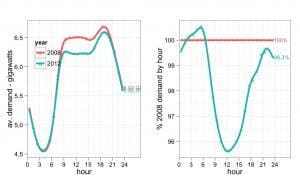There are many benefits of solar energy at both residential and commercial levels. At Solar Choice we provide free impartial advice about going solar and can give our customers a realistic idea of the advantages and disadvantages of solar energy for their home or commercial property.
So what are the advantages of solar energy?
It really depends on what angle you’re coming from, switching to solar power has lots benefits at lots of levels. The best solar power has to offer is saving you money on your energy bills and, depending on the size of your solar PV system and energy usage, can even make you a little extra if there are Solar Feed-in Tariffs available in your state or territory. With energy prices forecast to increase in the futures solar PV will continue to have short payback times despite the withdrawal of incentives.
Although much has been made of the Carbon Price the affect on current energy bills is negligible with many experts highlighting the disparity between the forecast increase on energy bills and the actual increases customers are seeing. The forecast cost of the Carbon Price was $16-18MWh while customers are actually seeing closer to $30MWh, meaning there is another factor affecting energy bills.
That factor could be the compensatory effect caused by the reduced demand for energy at peak times, when the utility companies make their money. Research by the University of Melbourne has shown that solar PV is having a dramatic effect on peak time demand from the grid, in an article written for the online blog, The Conversation, Dr Mike Sandiford explains what we should be seeing as a result of the uptake of solar PV over the past 3 years.
“Since solar PV production rises and falls in a characteristic pattern through the daylight hours, any substantive impact should be evident in a distinct reduction in demand for mains electricity in the middle of the day. With PV penetration having risen so dramatically since 2009, that pattern should be apparent in comparisons of demand over the last 12 months with equivalent periods prior to 2009.
In fact when we do this, the PV signature is blindingly obvious, especially in the states of South Australia and Queensland where PV penetration is highest. It is also showing itself in the revenues generated by electricity sold on the wholesale market.”
This essentially mean that we have lowered our reliance on the grid through investing in small scale solar PV installations, this is problematic for utilities companies as they rely on our purchasing energy at peak times to fund distribution (or getting the power to us, the great thing about solar PV is it’s produced where it’s needed) so the inevitable result is an increase in the cost of energy. As more people invest in solar PV to offset the rising cost of energy utilities companies will be forced to increase costs to cover the cost of distribution, going on until most homes have solar PV installed and have implemented energy efficiency measures.
And the disadvantages?
The main problem with using the sun is it’s not there for half the day, and our sunlight hours fluctuate over the year. Due to the heat in Australia we increase our usage during the summer and investing in a solar PV system can be a great way of offsetting the cost of your air conditioning. However, many solar PV systems are no match for the energy requirement of a heating system in winter due to decreased sun strength and fewer sunshine hours.
With the addition of a battery storage system you are able to make considerably more use of the energy generated by your panels but the cost of adding batteries to your system and prohibitive for many customers. There are developments taking place globally to address this storage situation with some countries developing commercial scale plants that trap the suns energy during the day and transform it into energy at night, as well as developments in batteries and electric cars that will allow us to make the most of the energy we capture from the sun.
For many people the cost of investing in solar PV is the main disadvantage to using the sun as a source of energy. Although the initial outlay does act as a barrier with government incentives and the growing cost of buying energy from the grid solar PV is swiftly becoming cheaper than traditional energy supply.
image via The Conversation – Who’s afraid of solar PV?
© 2012 Solar Choice Pty Ltd
- NSW Club industry choosing solar power, with help from Solar Choice - 16 October, 2014
- 100% Renewables celebrates solar BBQ success - 26 February, 2013
- Coal fired power station in Queensland to be converted to ‘clean energy park’ - 21 February, 2013

I love this information I know lots of things now and I feel very smart my daughter Laura loves electricity and thinks this information is amazing and she keeps watching me on this website